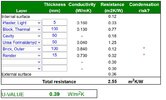- Joined
- 31 Jan 2025
- Messages
- 4
- Reaction score
- 0
- Country

Hello,
I have a late 70s built semi detached house that has pebble dash above the ground floor window and porch up to the soffits. The pebble dashing is starting to crack and we've had some water ingress to the porch. In light of this we're looking at getting the front elevation rendered in an Eco Rend product (will probably go for a similar colour to the pebble dashing (beige) in light of planning and not making a significant change to the appearance).
My question is with regards to the building regs approval required for modification of a thermal element. Since its over 50% of the thermal element, we'll need to submit a notice, but I'm wondering about the U-values. I've used an online calculator and put in, to the best of my knowledge, the materials used in the construction of the house, and it states that the U-value is 0.39 (see image), which exceeds both the threshold and the improved value in approved document L. Does this seem about right? And if so, can I just submit this with my building notice and go ahead with the work assuming there will be no issues later?
Thanks in advance, and please point out anything I'm missing.
Harry.
I have a late 70s built semi detached house that has pebble dash above the ground floor window and porch up to the soffits. The pebble dashing is starting to crack and we've had some water ingress to the porch. In light of this we're looking at getting the front elevation rendered in an Eco Rend product (will probably go for a similar colour to the pebble dashing (beige) in light of planning and not making a significant change to the appearance).
My question is with regards to the building regs approval required for modification of a thermal element. Since its over 50% of the thermal element, we'll need to submit a notice, but I'm wondering about the U-values. I've used an online calculator and put in, to the best of my knowledge, the materials used in the construction of the house, and it states that the U-value is 0.39 (see image), which exceeds both the threshold and the improved value in approved document L. Does this seem about right? And if so, can I just submit this with my building notice and go ahead with the work assuming there will be no issues later?
Thanks in advance, and please point out anything I'm missing.
Harry.

